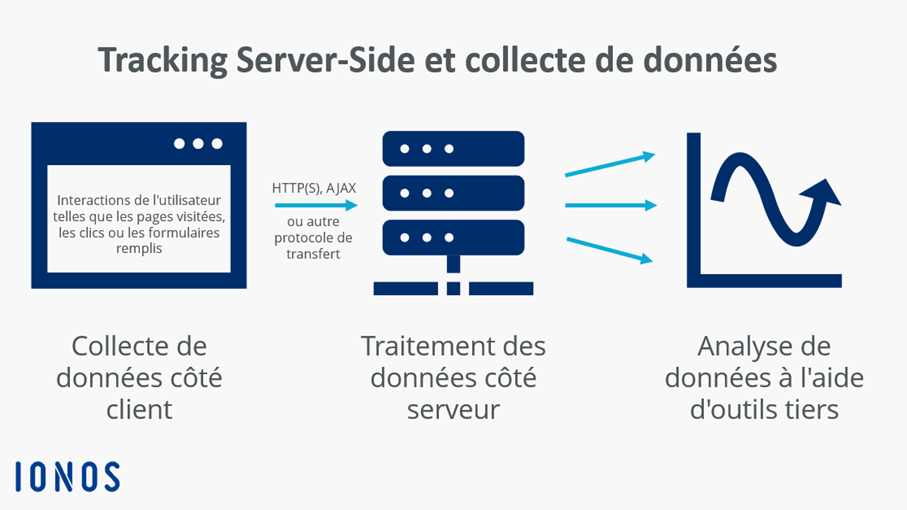Server-Side Tracking is a method of data collection in online marketing, in which the processing of user data does not take place in the end user's browser, but rather on the server of the website operator Web.
What is Tracking Server-Side used for?¶
Until now, online marketing has used web beacons or third-party cookies to track visits to a website, collect user data and thus target advertising. However, businesses must adapt to new challenges posed by improved data protection and stricter cookie regulations. At the same time, the use of ad blocking software forces them to look for reliable alternatives. These alternatives must provide accurate data without violating GDPR or being limited by browser restrictions. An alternative solution to these problems is Server-Side Tracking, also called “server side tracking” in French.
Server-Side Tracking allows you to track and analyze different types of user interactions on a website. These typically include clicks, pages visited, forms filled out, transactions, and other actions that users take on a website. Although server-side tracking works independently of cookies, first-party cookies can also be used here to collect and store additional information about users.
Server-side tracking allows website operators to collect personal data about user behavior in order to make informed decisions regarding marketing strategies, website optimization and user experience. It allows for accurate and reliable data collection because data processing takes place directly on the server, making it less vulnerable to ad blockers and other similar tools.
Managed Kubernetes from IONOS
The easiest way to manage containerized workloads. Automated configuration of Kubernetes clusters as well as maximum visibility and control of K8s clusters.
Persistent storage
24/7 support
Automated cluster configuration
What are the advantages of Tracking Server-Side?¶
Server-Side Tracking offers a number of advantages over traditional client-side tracking:
- Data protection compliance : By processing user data on its own server, it is thus possible to better comply with data protection directives, in particular the strict provisions of the General Data Protection Regulation (GDPR) in Europe.
- Increased security : As data processing takes place on the server, security risks such as data leaks or XSS (cross-site scripting) vulnerabilities can be reduced. Sensitive information is not processed in the user's browser, decreasing the risk of data misuse.
- Strategy of Data First Party : This approach supports a Data First Party strategy, which allows companies to collect and use their own data directly instead of relying on cookies from third-party providers.
- Cookie-free tracking : Server-Side Tracking allows businesses to harness the potential of cookieless tracking through alternative data collection methods to understand user behavior. This makes it possible to create personalized experiences without relying on cookies.
- Better data collection : Server-side tracking allows you to collect more accurate and reliable data. As the processing takes place on the server, the data is less vulnerable to Adblockers.
- Enrichment of data collection : Companies can enrich the scope of user data collection. By combining tracking data with other data sources, businesses can build a complete picture of their target groups and create even more personalized experiences.
- Scalability : Server-Side Tracking allows you to process large amounts of data and scale based on website traffic. This ensures efficient processing, even for busy websites.
- Flexibility : By implementing custom tracking logics and integrating various analytics platforms, server-side tracking provides great flexibility. Website owners can adjust their needs and develop tailor-made solutions.
How does Server-Side Tracking work?
Unlike traditional client-side tracking, where data processing takes place in the user's browser, server-side tracking involves this processing taking place on the website owner's server. To do this, JavaScript code is integrated into the website to collect data, which is then sent to the server hosting the site. The data is then processed in compliance with data protection before ultimately being passed on to third parties such as Google Analytics. The Server-Side Tracking process, combined with client-side JavaScript, works as follows:
- Client-side data collection : When a user visits a website, the JavaScript tracking script loads and runs in their browser. This script records user interactions on the site, such as clicks, pages viewed and forms filled out.
- Data transmission to server : The data collected by the JavaScript is sent to the server of the website operator, either immediately or at regular intervals. This is usually done via HTTP requests, AJAX requests or other data transmission methods.
- Server-side processing : Incoming data is analyzed and processed on the server. This usually involves extracting relevant information from the received data, such as the user's IP address, time of action, and other user-defined data.
- Aggregation and storage : Processed data is stored in a database or analytics platform and used for subsequent analysis and reporting.
- Transfer to analysis tools : Once processed, the data can be transferred to analysis tools, databases or other destinations for further analysis or for use in other systems.





